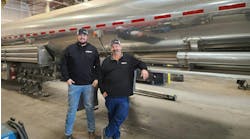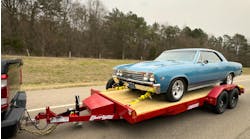Led by a double-digit gain in sales for the Final Mile Products division, Wabash National Corp. reported an all-time record revenue of $626 million in the second quarter, along with its best operating margin in two years.
The strong performance is a product of the company’s focus on building “an even stronger and more resilient Wabash business portfolio,” explained Wabash President and CEO Brent Yeagy in an earnings call with investment analysts.
“Over the past year, we have taken necessary steps and committed the additional resources required to drive focus and systematic change in how we plan, manage and execute those business systems that enable powerful performance,” Yeagy said. “Results are now emerging, people are believing, and we are just getting started.”
Specifically, Yeagy pointed to the 2017 acquisition of truck-body builder Supreme Industries. The Final Mile division posted revenue of $135 million in the quarter, up 11% from the previous high in the second quarter last year.
“We have grown the legacy Supreme business by 40% since bringing it on board. The pace of our growth in the Final Mile business segment remains well beyond our initial expectations,” he said. “We are clearly focused on broadening beyond the Supreme business and building the Final Mile Products group into a strategic force within the broad and integrated world of final-mile transportation, logistics and distribution, while continuing to implement the structural improvements that enable Final Mile Products to grow profitably.”
He cited a 26% improvement in the overall OSHA recordable incident rate as “a leading indicator of positive overall operational system change” within the group.
Commercial Trailer Products, the company’s core business, saw new sales slip to $400.1 million from $402.5 million in the second quarter last year. Wabash shipped 14,250 new trailers in Q2, down from 15,650 the year before. Yeagy characterized the performance as “in line with expectations.”
Backlog at the end the second quarter was $1.2 billion, with production essentially booked through the end of the year.
“While order cancellations in the broader industry may have increased recently, we have not experienced the same phenomenon, and our order cancellations remain within normal levels,” Yeagy said, and he pointed to recent volatility in spot freight rates and the impact on small carriers. “I think that some of our competition decided to take maybe a higher level of speculative order that went into 2020. We manage our backlog in a much more prudent manner. Our dealer base is stronger, which minimizes the effect of the small and medium-sized customer pulling back.”
The Diversified Products Group, which includes specialty trailers such as tankers and the Wabash composites business, delivered “solid” top line growth, up 3.1% from a year ago on revenue of $94.1 million, and an operating margin of 9.2%—the highest in three years. Yeagy credited product design standardization, enhanced sales and operations planning and velocity-based lean manufacturing for the unit’s improvement.
Since the end of the second quarter last year, Yeagy explained that the company has improved its operating margins by overcoming “raw material headwinds, supplier disruptions and labor challenges.” Looking ahead, Yeagy anticipates positive macroeconomic fundamentals through the rest of 2019.
Wabash will open its order book for 2020 in a “more traditional” September window, Yeagy added.
“We're experiencing a level of deceleration in the market—they're taking a timeout right now in the mid-summer to understand what their capital needs will be,” he said. “So we're going to move to more of a traditional period off of those peak demand levels. And there's nothing surprising about that.”
Speaking specifically of large fleet customers about their 2020 outlook, Yeagy called their market expectation “stable,” with continued high levels of cash generation and high levels of operating margin.
“They're not concerned necessarily about their ability to purchase equipment,” Yeagy said. “They're just trying to hone it down right now to what their exact expectations will be.”
Looking toward the next 24 to 36 months, Yeagy suggested that he’s going to be watching national and global economic trends.
“Things can turn on a dime, up or down, depending on what happens with trade policy, the Fed, or an election that's around the corner: All those things can be net favorable, if they turn out a certain way with certain timing,” Yeagy said. “Vice versa, depending on how those go, they can have somewhat of a negative impact. And that is a much harder situation to understand. And I'm not going to try to put odds on any of that right now.
“We're going to manage our business based on what we control and whatever the market throws at us, we're going to be able to do it better than we do it today.”
Similarly, Wabash is positioned to grow regardless of changes in product mix as the supply chain responds to the needs of e-commerce.
“This dynamic change in logistics, distribution and transportation that's going on right now—it’s bigger than just final mile,” Yeagy said. “This is now one ecosystem. People need to understand that. These are not two different businesses. This is one now connected logistics chain with a set of disruptors that's moving through all three phases: first, middle and final mile.”
In terms of trailer specs, Yeagy suggested that manufacturers—during this period of supply chain transition—might no longer design and engineer products around a 10- to 12-year life cycle, but a rather a shorter 5-year range, and match warranties and equipment turnover more like truck asset management.
“On top of that, you've got the disruption changes where things like lift gates are popping up at higher and higher percentages, both on the Final Mile Product side as well as on the truck side, as we go to shorter and shorter hauls, different applications—logistic models are changing,” Yeagy said. “You're seeing different specs begin to come through, in terms of more flexible assets, in general. The shift is under way in real life.”
“We see that right now within our FMP business, where the growth that we're experiencing far exceeds anything that you could proxy off of the medium-duty chassis type of economic output. And we think that's going to grow and continue to diverge.”










